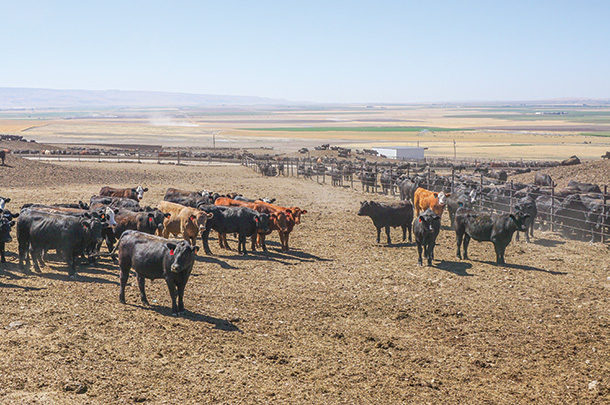The full swing of summer will bring high temperatures, high humidity and high chances of heat stress. Heat stress is a major concern in the beef industry, causing countless problems in cattle, such as a big swing in feed intake and negative changes in the rumen. Ultimately, this leads to diminished feed utilization and a significant negative impact on animal performance.
Feedlot cattle can begin to experience heat stress at much lower temperatures than a person might think. In the spring, heat stress can happen at temperatures as low as 80ºF, and in the summer as low as 90ºF if there is a high level of humidity or poor air movement.
Although producers cannot control the weather, you can be proactive to minimize the effects of heat stress. The saying “an ounce of prevention is worth a pound of cure” is very applicable here. The U.S. Meat Animal Research Center publishes a heat stress forecasting tool that is free to cattle producers. It provides a seven-day heat stress outlook by region.
There are several things you can proactively do before the heat arrives to minimize its impact on animal performance. The way your facilities are laid out are fixed, and some locations will be more prone to having poorer air flow, where you might have to take additional precautions.
Facility tips
-
Air flow – Increasing air flow can help cattle cope with extreme heat. Remove any wind barriers such as equipment, weeds, hay bales and tall vegetation around pens.
-
Water – Cattle will typically double their water consumption as it gets hotter. Providing enough water starts at having enough well capacity and a big enough water trough for the amount of cattle in a pen. Water will be the cheapest nutrient you will ever put into your cattle. If your well struggles during fall or winter to keep up, think about adding on-site storage. Additional tanks in the pen allow/encourage cattle to drink, which can also pay dividends.
-
Shade – Providing shade (permanent or temporary) can be a cost-effective way to help cattle cope with heat stress. Placing shade closer to the bunk will help encourage cattle to eat more meals throughout the day.
- Sprinklers – Installing sprinklers is another way to help cattle keep their temperature in check. It’s best to have sprinklers on a timer to minimize water waste and prevent pens from getting too muddy. Wetting the pen floor is also effective at cooling cattle and giving them a much cooler surface to lie down on, encouraging them to lie down.
Feeding tips
-
Reduce feed offered – If you have a heat event that is forecast, reducing feed offered to the pen in the morning can be effective at preventing excess amounts of feed being left in bunk the next day. A reduction in feed offered in the afternoon is often too late because cattle will begin to get hot around noon and just get hotter through the afternoon, leading them to eat less or no feed at all, depending on how hot it gets. Work with a nutritionist to come up with a game plan.
-
Reducing energy content – There is research that shows reducing the energy density of the diet can be effective at reducing heat stress in cattle. Most nutritionists or feedlots are unwilling to do this for several reasons, but if you suffer from severe heat events, it might be worth looking at.
- Use an appropriate ration – Work with a nutritionist to ensure that you have adequate energy, protein, vitamin and mineral levels. Certain feed additives that can provide benefits to animal performance during normal weather can pay extra bonuses during heat stress events. Those additives should have proven research that it modulates the rumen and improves gut health. If it does, this will help cattle stay on feed and, ultimately, be more profitable.
Management tips
-
Move animals early – During heat events, working cattle in the morning is the best time of day. It might seem working cattle after the sun goes down is a good idea. However, the peak heat load for cattle occurs approximately two hours after the peak temperature of the day. It takes about six hours after that peak heat load for cattle to cool down. So cattle are still quite hot well into the evening.
- Bedding – Providing bedding in the pen during a heat event may seem counterintuitive, but bedding cattle can lower the surface temperature by a significant amount. Getting cattle to lie down reduces their energy maintenance requirements and will lead to better performance.
As temperatures continue to rise, so do concerns regarding heat stress in cattle. Heat stress can lead to reduced intake, decreased digestibility and diminished performance. By following the steps above, cattle producers can help beat the heat in beef cattle.










